BUS789: Sustainable Tourism Development in Egypt - Report
VerifiedAdded on 2023/01/18
|17
|6258
|79
Report
AI Summary
This report provides a comprehensive analysis of sustainable tourism development, focusing on the case of Egypt. It begins with an introduction to sustainable tourism and its importance, followed by a discussion of stakeholder benefits from tourism development planning in Egypt and the advantages and disadvantages of public/private sector tourism planning partnerships. The report then delves into the features of tourism development planning at different levels (international, national, regional, and sub-regional) and evaluates the significance of interactive planning systems and processes. It also explores various methods for measuring tourist impact. Further, the report justifies the introduction of sustainability in tourism development in Egypt, analyzes factors hindering sustainable tourism, and examines different stages of planning for sustainability. It also covers methods for resolving conflicts of interest, implications of balancing supply and demand, and ethical issues in enclave tourism. Finally, the report compares current tourism issues in Egypt and Thailand, offering recommendations for future tourism development in destinations.
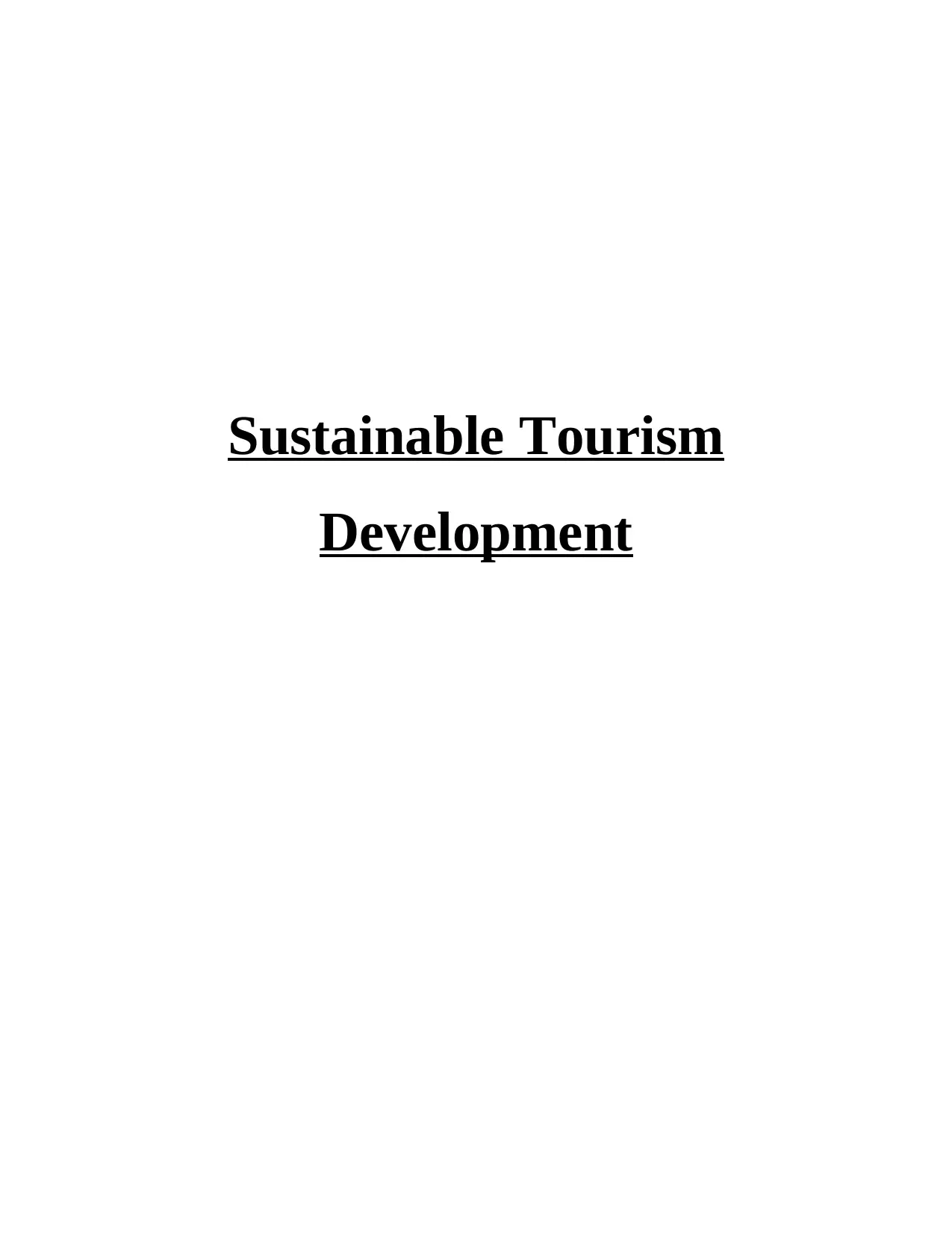
Sustainable Tourism
Development
Development
Paraphrase This Document
Need a fresh take? Get an instant paraphrase of this document with our AI Paraphraser
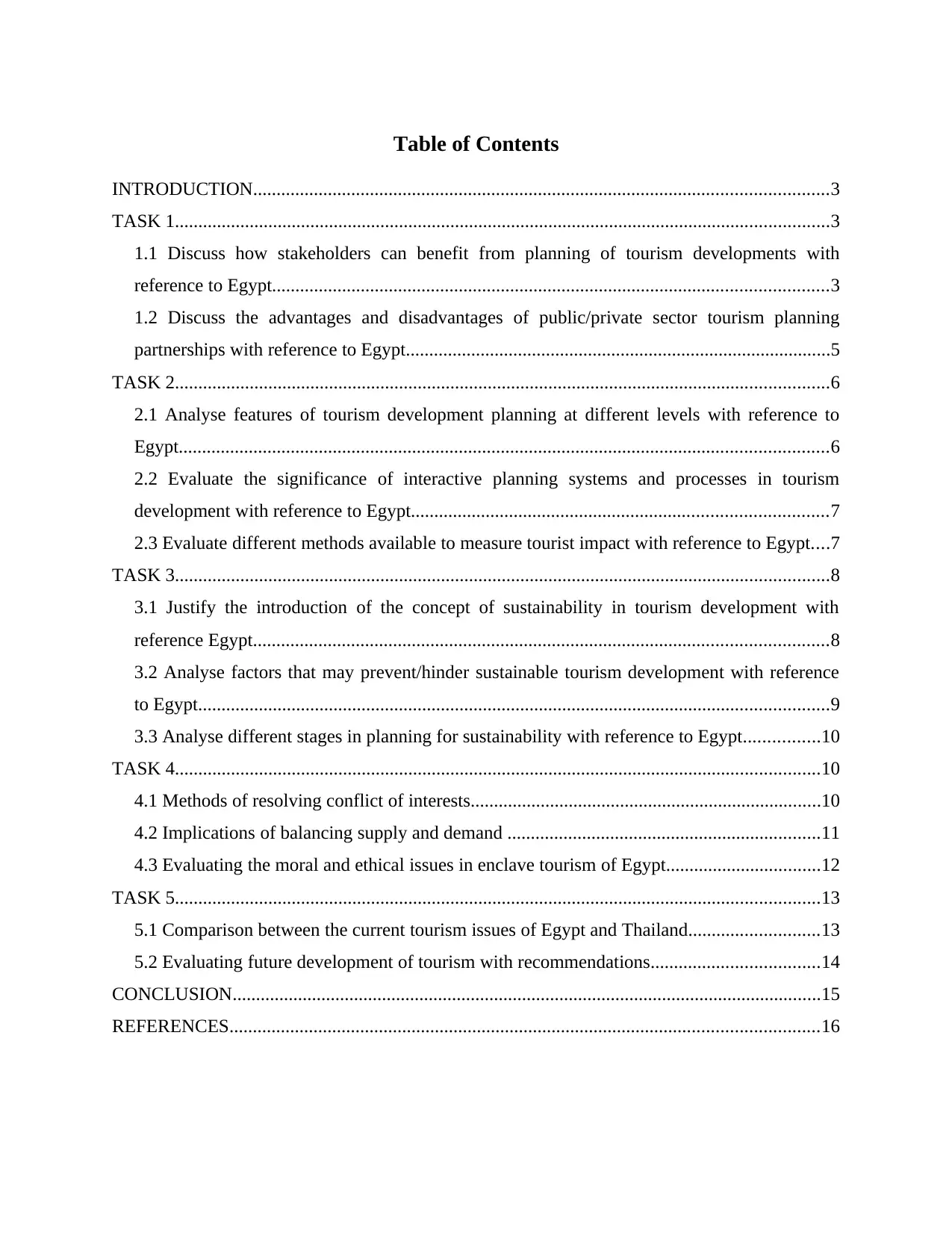
Table of Contents
INTRODUCTION...........................................................................................................................3
TASK 1............................................................................................................................................3
1.1 Discuss how stakeholders can benefit from planning of tourism developments with
reference to Egypt.......................................................................................................................3
1.2 Discuss the advantages and disadvantages of public/private sector tourism planning
partnerships with reference to Egypt...........................................................................................5
TASK 2............................................................................................................................................6
2.1 Analyse features of tourism development planning at different levels with reference to
Egypt...........................................................................................................................................6
2.2 Evaluate the significance of interactive planning systems and processes in tourism
development with reference to Egypt.........................................................................................7
2.3 Evaluate different methods available to measure tourist impact with reference to Egypt....7
TASK 3............................................................................................................................................8
3.1 Justify the introduction of the concept of sustainability in tourism development with
reference Egypt...........................................................................................................................8
3.2 Analyse factors that may prevent/hinder sustainable tourism development with reference
to Egypt.......................................................................................................................................9
3.3 Analyse different stages in planning for sustainability with reference to Egypt................10
TASK 4..........................................................................................................................................10
4.1 Methods of resolving conflict of interests...........................................................................10
4.2 Implications of balancing supply and demand ...................................................................11
4.3 Evaluating the moral and ethical issues in enclave tourism of Egypt.................................12
TASK 5..........................................................................................................................................13
5.1 Comparison between the current tourism issues of Egypt and Thailand............................13
5.2 Evaluating future development of tourism with recommendations....................................14
CONCLUSION..............................................................................................................................15
REFERENCES..............................................................................................................................16
INTRODUCTION...........................................................................................................................3
TASK 1............................................................................................................................................3
1.1 Discuss how stakeholders can benefit from planning of tourism developments with
reference to Egypt.......................................................................................................................3
1.2 Discuss the advantages and disadvantages of public/private sector tourism planning
partnerships with reference to Egypt...........................................................................................5
TASK 2............................................................................................................................................6
2.1 Analyse features of tourism development planning at different levels with reference to
Egypt...........................................................................................................................................6
2.2 Evaluate the significance of interactive planning systems and processes in tourism
development with reference to Egypt.........................................................................................7
2.3 Evaluate different methods available to measure tourist impact with reference to Egypt....7
TASK 3............................................................................................................................................8
3.1 Justify the introduction of the concept of sustainability in tourism development with
reference Egypt...........................................................................................................................8
3.2 Analyse factors that may prevent/hinder sustainable tourism development with reference
to Egypt.......................................................................................................................................9
3.3 Analyse different stages in planning for sustainability with reference to Egypt................10
TASK 4..........................................................................................................................................10
4.1 Methods of resolving conflict of interests...........................................................................10
4.2 Implications of balancing supply and demand ...................................................................11
4.3 Evaluating the moral and ethical issues in enclave tourism of Egypt.................................12
TASK 5..........................................................................................................................................13
5.1 Comparison between the current tourism issues of Egypt and Thailand............................13
5.2 Evaluating future development of tourism with recommendations....................................14
CONCLUSION..............................................................................................................................15
REFERENCES..............................................................................................................................16
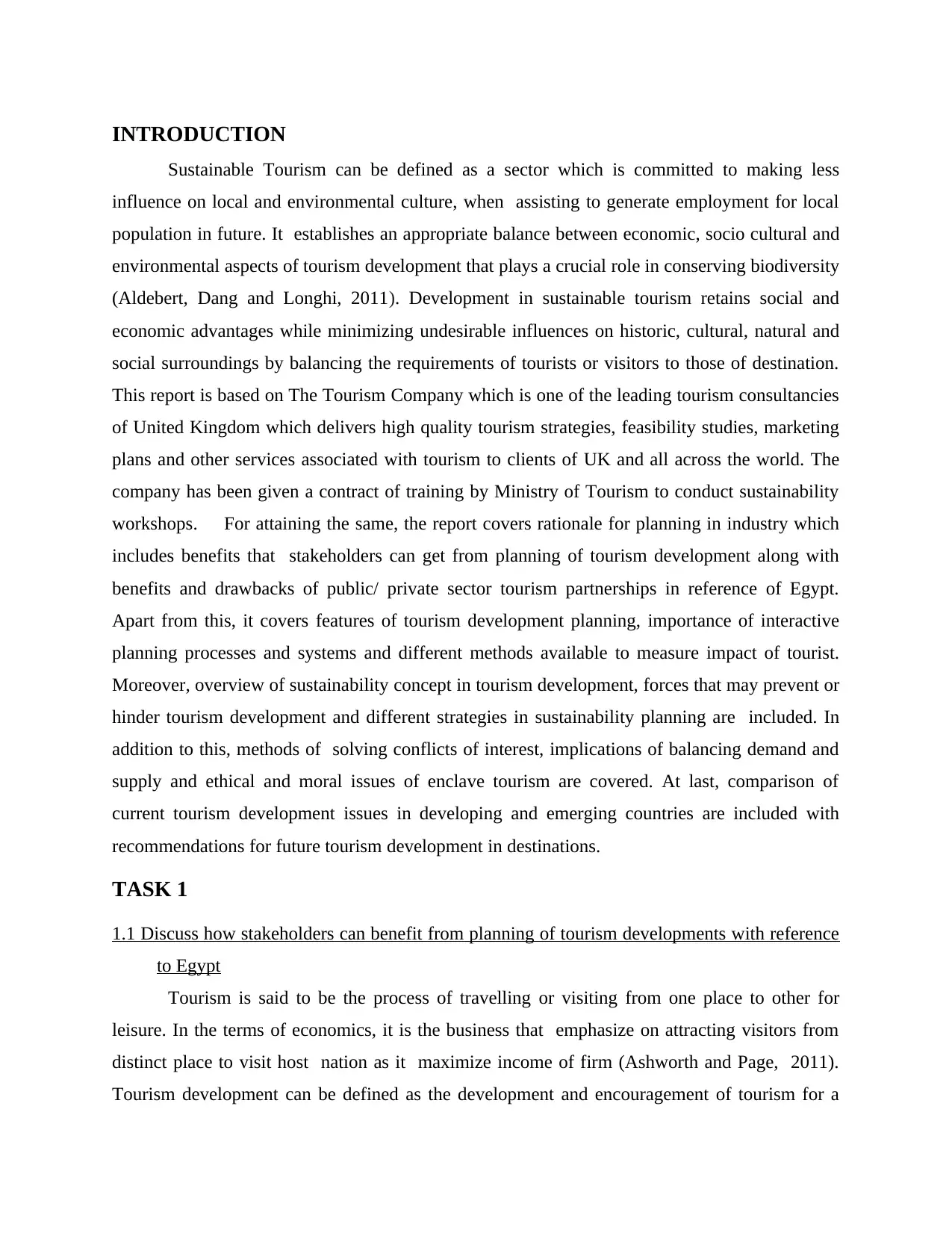
INTRODUCTION
Sustainable Tourism can be defined as a sector which is committed to making less
influence on local and environmental culture, when assisting to generate employment for local
population in future. It establishes an appropriate balance between economic, socio cultural and
environmental aspects of tourism development that plays a crucial role in conserving biodiversity
(Aldebert, Dang and Longhi, 2011). Development in sustainable tourism retains social and
economic advantages while minimizing undesirable influences on historic, cultural, natural and
social surroundings by balancing the requirements of tourists or visitors to those of destination.
This report is based on The Tourism Company which is one of the leading tourism consultancies
of United Kingdom which delivers high quality tourism strategies, feasibility studies, marketing
plans and other services associated with tourism to clients of UK and all across the world. The
company has been given a contract of training by Ministry of Tourism to conduct sustainability
workshops. For attaining the same, the report covers rationale for planning in industry which
includes benefits that stakeholders can get from planning of tourism development along with
benefits and drawbacks of public/ private sector tourism partnerships in reference of Egypt.
Apart from this, it covers features of tourism development planning, importance of interactive
planning processes and systems and different methods available to measure impact of tourist.
Moreover, overview of sustainability concept in tourism development, forces that may prevent or
hinder tourism development and different strategies in sustainability planning are included. In
addition to this, methods of solving conflicts of interest, implications of balancing demand and
supply and ethical and moral issues of enclave tourism are covered. At last, comparison of
current tourism development issues in developing and emerging countries are included with
recommendations for future tourism development in destinations.
TASK 1
1.1 Discuss how stakeholders can benefit from planning of tourism developments with reference
to Egypt
Tourism is said to be the process of travelling or visiting from one place to other for
leisure. In the terms of economics, it is the business that emphasize on attracting visitors from
distinct place to visit host nation as it maximize income of firm (Ashworth and Page, 2011).
Tourism development can be defined as the development and encouragement of tourism for a
Sustainable Tourism can be defined as a sector which is committed to making less
influence on local and environmental culture, when assisting to generate employment for local
population in future. It establishes an appropriate balance between economic, socio cultural and
environmental aspects of tourism development that plays a crucial role in conserving biodiversity
(Aldebert, Dang and Longhi, 2011). Development in sustainable tourism retains social and
economic advantages while minimizing undesirable influences on historic, cultural, natural and
social surroundings by balancing the requirements of tourists or visitors to those of destination.
This report is based on The Tourism Company which is one of the leading tourism consultancies
of United Kingdom which delivers high quality tourism strategies, feasibility studies, marketing
plans and other services associated with tourism to clients of UK and all across the world. The
company has been given a contract of training by Ministry of Tourism to conduct sustainability
workshops. For attaining the same, the report covers rationale for planning in industry which
includes benefits that stakeholders can get from planning of tourism development along with
benefits and drawbacks of public/ private sector tourism partnerships in reference of Egypt.
Apart from this, it covers features of tourism development planning, importance of interactive
planning processes and systems and different methods available to measure impact of tourist.
Moreover, overview of sustainability concept in tourism development, forces that may prevent or
hinder tourism development and different strategies in sustainability planning are included. In
addition to this, methods of solving conflicts of interest, implications of balancing demand and
supply and ethical and moral issues of enclave tourism are covered. At last, comparison of
current tourism development issues in developing and emerging countries are included with
recommendations for future tourism development in destinations.
TASK 1
1.1 Discuss how stakeholders can benefit from planning of tourism developments with reference
to Egypt
Tourism is said to be the process of travelling or visiting from one place to other for
leisure. In the terms of economics, it is the business that emphasize on attracting visitors from
distinct place to visit host nation as it maximize income of firm (Ashworth and Page, 2011).
Tourism development can be defined as the development and encouragement of tourism for a
⊘ This is a preview!⊘
Do you want full access?
Subscribe today to unlock all pages.

Trusted by 1+ million students worldwide
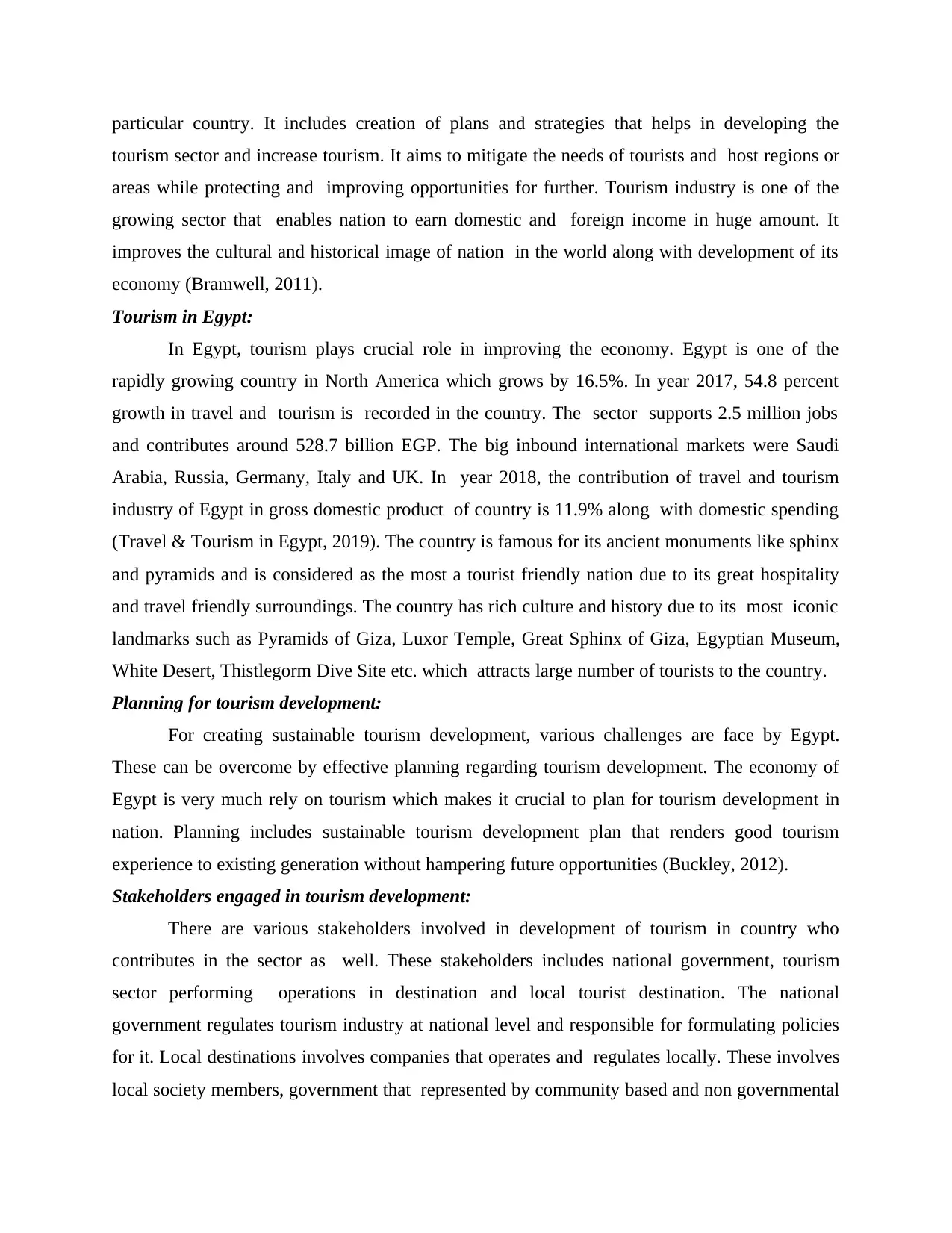
particular country. It includes creation of plans and strategies that helps in developing the
tourism sector and increase tourism. It aims to mitigate the needs of tourists and host regions or
areas while protecting and improving opportunities for further. Tourism industry is one of the
growing sector that enables nation to earn domestic and foreign income in huge amount. It
improves the cultural and historical image of nation in the world along with development of its
economy (Bramwell, 2011).
Tourism in Egypt:
In Egypt, tourism plays crucial role in improving the economy. Egypt is one of the
rapidly growing country in North America which grows by 16.5%. In year 2017, 54.8 percent
growth in travel and tourism is recorded in the country. The sector supports 2.5 million jobs
and contributes around 528.7 billion EGP. The big inbound international markets were Saudi
Arabia, Russia, Germany, Italy and UK. In year 2018, the contribution of travel and tourism
industry of Egypt in gross domestic product of country is 11.9% along with domestic spending
(Travel & Tourism in Egypt, 2019). The country is famous for its ancient monuments like sphinx
and pyramids and is considered as the most a tourist friendly nation due to its great hospitality
and travel friendly surroundings. The country has rich culture and history due to its most iconic
landmarks such as Pyramids of Giza, Luxor Temple, Great Sphinx of Giza, Egyptian Museum,
White Desert, Thistlegorm Dive Site etc. which attracts large number of tourists to the country.
Planning for tourism development:
For creating sustainable tourism development, various challenges are face by Egypt.
These can be overcome by effective planning regarding tourism development. The economy of
Egypt is very much rely on tourism which makes it crucial to plan for tourism development in
nation. Planning includes sustainable tourism development plan that renders good tourism
experience to existing generation without hampering future opportunities (Buckley, 2012).
Stakeholders engaged in tourism development:
There are various stakeholders involved in development of tourism in country who
contributes in the sector as well. These stakeholders includes national government, tourism
sector performing operations in destination and local tourist destination. The national
government regulates tourism industry at national level and responsible for formulating policies
for it. Local destinations involves companies that operates and regulates locally. These involves
local society members, government that represented by community based and non governmental
tourism sector and increase tourism. It aims to mitigate the needs of tourists and host regions or
areas while protecting and improving opportunities for further. Tourism industry is one of the
growing sector that enables nation to earn domestic and foreign income in huge amount. It
improves the cultural and historical image of nation in the world along with development of its
economy (Bramwell, 2011).
Tourism in Egypt:
In Egypt, tourism plays crucial role in improving the economy. Egypt is one of the
rapidly growing country in North America which grows by 16.5%. In year 2017, 54.8 percent
growth in travel and tourism is recorded in the country. The sector supports 2.5 million jobs
and contributes around 528.7 billion EGP. The big inbound international markets were Saudi
Arabia, Russia, Germany, Italy and UK. In year 2018, the contribution of travel and tourism
industry of Egypt in gross domestic product of country is 11.9% along with domestic spending
(Travel & Tourism in Egypt, 2019). The country is famous for its ancient monuments like sphinx
and pyramids and is considered as the most a tourist friendly nation due to its great hospitality
and travel friendly surroundings. The country has rich culture and history due to its most iconic
landmarks such as Pyramids of Giza, Luxor Temple, Great Sphinx of Giza, Egyptian Museum,
White Desert, Thistlegorm Dive Site etc. which attracts large number of tourists to the country.
Planning for tourism development:
For creating sustainable tourism development, various challenges are face by Egypt.
These can be overcome by effective planning regarding tourism development. The economy of
Egypt is very much rely on tourism which makes it crucial to plan for tourism development in
nation. Planning includes sustainable tourism development plan that renders good tourism
experience to existing generation without hampering future opportunities (Buckley, 2012).
Stakeholders engaged in tourism development:
There are various stakeholders involved in development of tourism in country who
contributes in the sector as well. These stakeholders includes national government, tourism
sector performing operations in destination and local tourist destination. The national
government regulates tourism industry at national level and responsible for formulating policies
for it. Local destinations involves companies that operates and regulates locally. These involves
local society members, government that represented by community based and non governmental
Paraphrase This Document
Need a fresh take? Get an instant paraphrase of this document with our AI Paraphraser
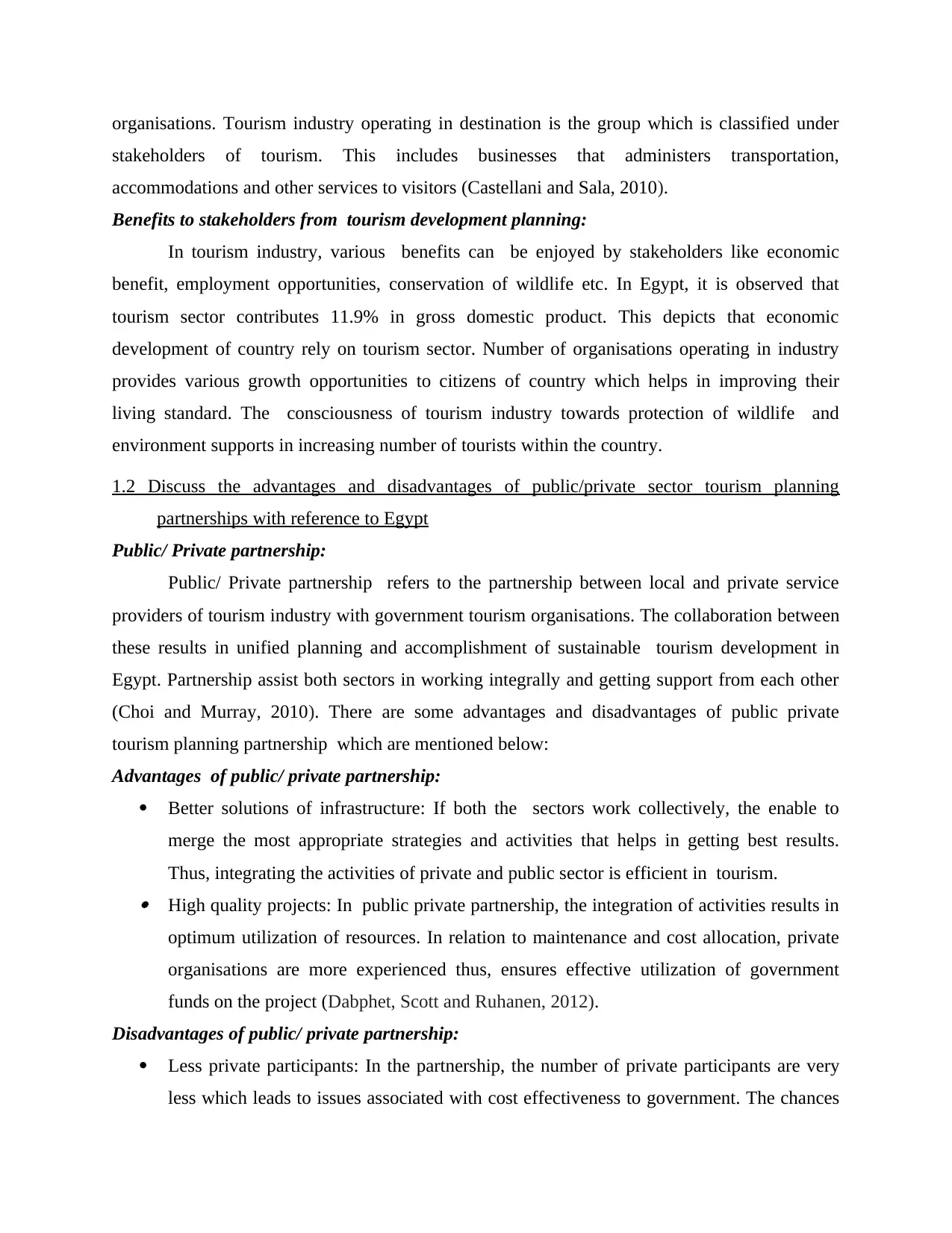
organisations. Tourism industry operating in destination is the group which is classified under
stakeholders of tourism. This includes businesses that administers transportation,
accommodations and other services to visitors (Castellani and Sala, 2010).
Benefits to stakeholders from tourism development planning:
In tourism industry, various benefits can be enjoyed by stakeholders like economic
benefit, employment opportunities, conservation of wildlife etc. In Egypt, it is observed that
tourism sector contributes 11.9% in gross domestic product. This depicts that economic
development of country rely on tourism sector. Number of organisations operating in industry
provides various growth opportunities to citizens of country which helps in improving their
living standard. The consciousness of tourism industry towards protection of wildlife and
environment supports in increasing number of tourists within the country.
1.2 Discuss the advantages and disadvantages of public/private sector tourism planning
partnerships with reference to Egypt
Public/ Private partnership:
Public/ Private partnership refers to the partnership between local and private service
providers of tourism industry with government tourism organisations. The collaboration between
these results in unified planning and accomplishment of sustainable tourism development in
Egypt. Partnership assist both sectors in working integrally and getting support from each other
(Choi and Murray, 2010). There are some advantages and disadvantages of public private
tourism planning partnership which are mentioned below:
Advantages of public/ private partnership:
Better solutions of infrastructure: If both the sectors work collectively, the enable to
merge the most appropriate strategies and activities that helps in getting best results.
Thus, integrating the activities of private and public sector is efficient in tourism. High quality projects: In public private partnership, the integration of activities results in
optimum utilization of resources. In relation to maintenance and cost allocation, private
organisations are more experienced thus, ensures effective utilization of government
funds on the project (Dabphet, Scott and Ruhanen, 2012).
Disadvantages of public/ private partnership:
Less private participants: In the partnership, the number of private participants are very
less which leads to issues associated with cost effectiveness to government. The chances
stakeholders of tourism. This includes businesses that administers transportation,
accommodations and other services to visitors (Castellani and Sala, 2010).
Benefits to stakeholders from tourism development planning:
In tourism industry, various benefits can be enjoyed by stakeholders like economic
benefit, employment opportunities, conservation of wildlife etc. In Egypt, it is observed that
tourism sector contributes 11.9% in gross domestic product. This depicts that economic
development of country rely on tourism sector. Number of organisations operating in industry
provides various growth opportunities to citizens of country which helps in improving their
living standard. The consciousness of tourism industry towards protection of wildlife and
environment supports in increasing number of tourists within the country.
1.2 Discuss the advantages and disadvantages of public/private sector tourism planning
partnerships with reference to Egypt
Public/ Private partnership:
Public/ Private partnership refers to the partnership between local and private service
providers of tourism industry with government tourism organisations. The collaboration between
these results in unified planning and accomplishment of sustainable tourism development in
Egypt. Partnership assist both sectors in working integrally and getting support from each other
(Choi and Murray, 2010). There are some advantages and disadvantages of public private
tourism planning partnership which are mentioned below:
Advantages of public/ private partnership:
Better solutions of infrastructure: If both the sectors work collectively, the enable to
merge the most appropriate strategies and activities that helps in getting best results.
Thus, integrating the activities of private and public sector is efficient in tourism. High quality projects: In public private partnership, the integration of activities results in
optimum utilization of resources. In relation to maintenance and cost allocation, private
organisations are more experienced thus, ensures effective utilization of government
funds on the project (Dabphet, Scott and Ruhanen, 2012).
Disadvantages of public/ private partnership:
Less private participants: In the partnership, the number of private participants are very
less which leads to issues associated with cost effectiveness to government. The chances
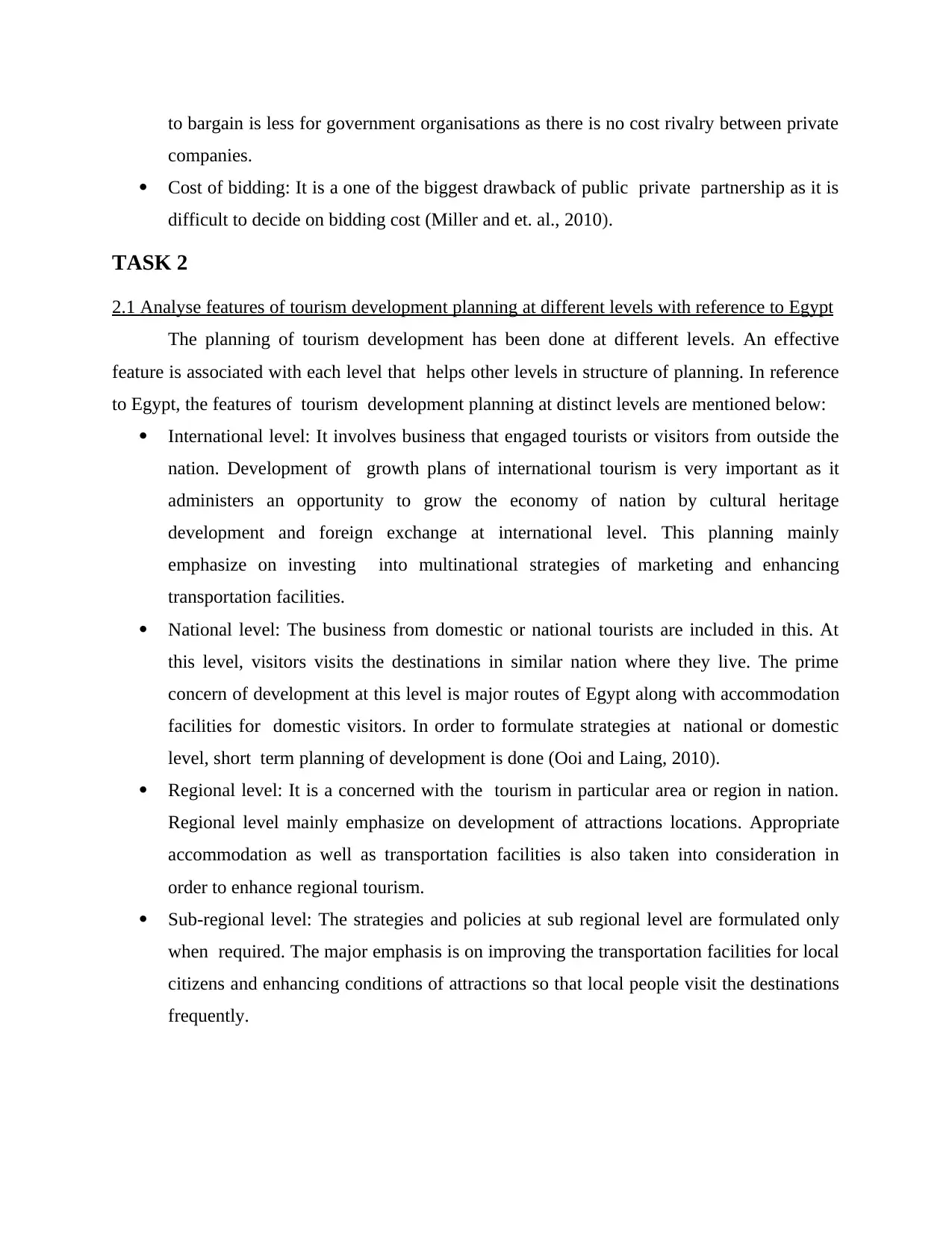
to bargain is less for government organisations as there is no cost rivalry between private
companies.
Cost of bidding: It is a one of the biggest drawback of public private partnership as it is
difficult to decide on bidding cost (Miller and et. al., 2010).
TASK 2
2.1 Analyse features of tourism development planning at different levels with reference to Egypt
The planning of tourism development has been done at different levels. An effective
feature is associated with each level that helps other levels in structure of planning. In reference
to Egypt, the features of tourism development planning at distinct levels are mentioned below:
International level: It involves business that engaged tourists or visitors from outside the
nation. Development of growth plans of international tourism is very important as it
administers an opportunity to grow the economy of nation by cultural heritage
development and foreign exchange at international level. This planning mainly
emphasize on investing into multinational strategies of marketing and enhancing
transportation facilities.
National level: The business from domestic or national tourists are included in this. At
this level, visitors visits the destinations in similar nation where they live. The prime
concern of development at this level is major routes of Egypt along with accommodation
facilities for domestic visitors. In order to formulate strategies at national or domestic
level, short term planning of development is done (Ooi and Laing, 2010).
Regional level: It is a concerned with the tourism in particular area or region in nation.
Regional level mainly emphasize on development of attractions locations. Appropriate
accommodation as well as transportation facilities is also taken into consideration in
order to enhance regional tourism.
Sub-regional level: The strategies and policies at sub regional level are formulated only
when required. The major emphasis is on improving the transportation facilities for local
citizens and enhancing conditions of attractions so that local people visit the destinations
frequently.
companies.
Cost of bidding: It is a one of the biggest drawback of public private partnership as it is
difficult to decide on bidding cost (Miller and et. al., 2010).
TASK 2
2.1 Analyse features of tourism development planning at different levels with reference to Egypt
The planning of tourism development has been done at different levels. An effective
feature is associated with each level that helps other levels in structure of planning. In reference
to Egypt, the features of tourism development planning at distinct levels are mentioned below:
International level: It involves business that engaged tourists or visitors from outside the
nation. Development of growth plans of international tourism is very important as it
administers an opportunity to grow the economy of nation by cultural heritage
development and foreign exchange at international level. This planning mainly
emphasize on investing into multinational strategies of marketing and enhancing
transportation facilities.
National level: The business from domestic or national tourists are included in this. At
this level, visitors visits the destinations in similar nation where they live. The prime
concern of development at this level is major routes of Egypt along with accommodation
facilities for domestic visitors. In order to formulate strategies at national or domestic
level, short term planning of development is done (Ooi and Laing, 2010).
Regional level: It is a concerned with the tourism in particular area or region in nation.
Regional level mainly emphasize on development of attractions locations. Appropriate
accommodation as well as transportation facilities is also taken into consideration in
order to enhance regional tourism.
Sub-regional level: The strategies and policies at sub regional level are formulated only
when required. The major emphasis is on improving the transportation facilities for local
citizens and enhancing conditions of attractions so that local people visit the destinations
frequently.
⊘ This is a preview!⊘
Do you want full access?
Subscribe today to unlock all pages.

Trusted by 1+ million students worldwide
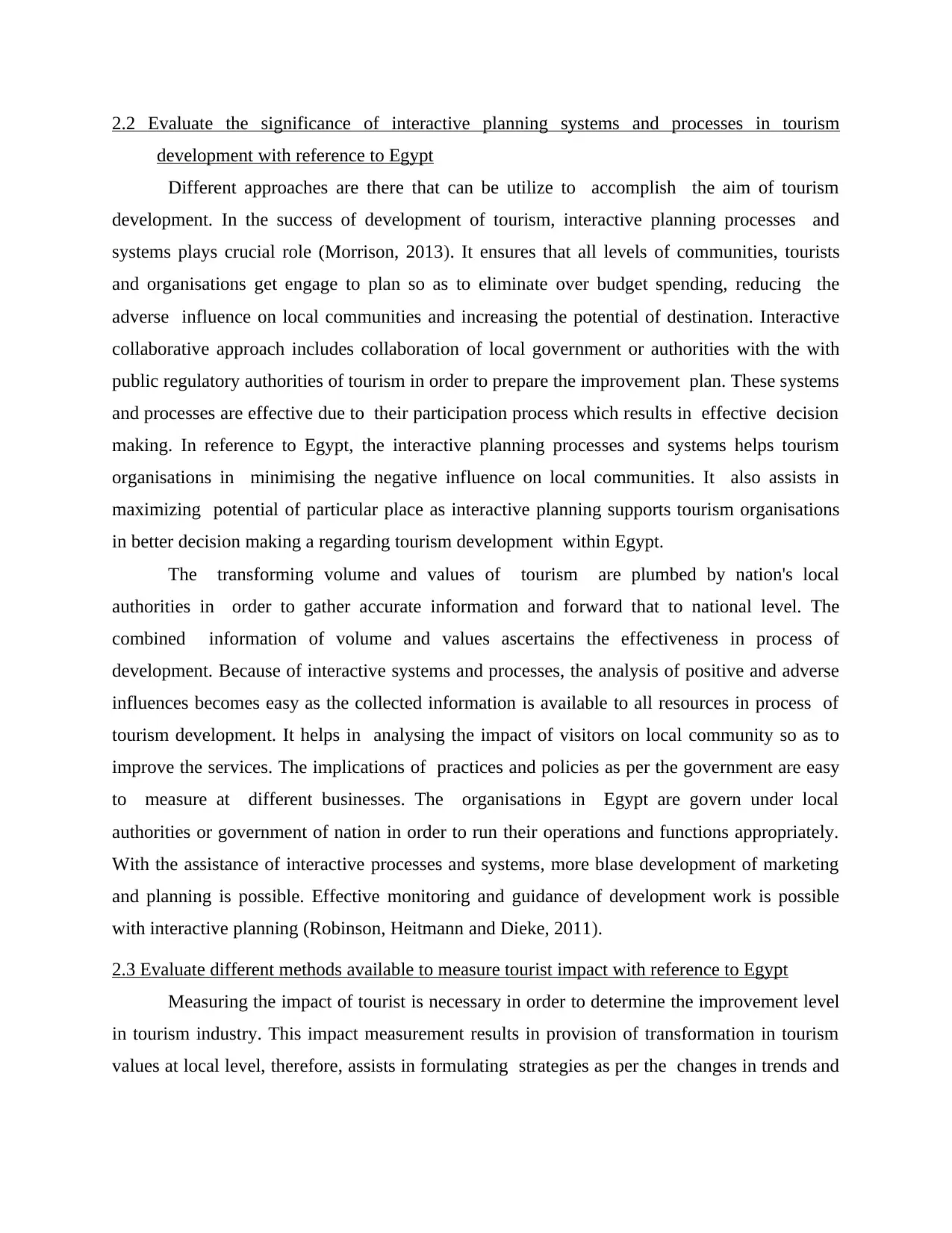
2.2 Evaluate the significance of interactive planning systems and processes in tourism
development with reference to Egypt
Different approaches are there that can be utilize to accomplish the aim of tourism
development. In the success of development of tourism, interactive planning processes and
systems plays crucial role (Morrison, 2013). It ensures that all levels of communities, tourists
and organisations get engage to plan so as to eliminate over budget spending, reducing the
adverse influence on local communities and increasing the potential of destination. Interactive
collaborative approach includes collaboration of local government or authorities with the with
public regulatory authorities of tourism in order to prepare the improvement plan. These systems
and processes are effective due to their participation process which results in effective decision
making. In reference to Egypt, the interactive planning processes and systems helps tourism
organisations in minimising the negative influence on local communities. It also assists in
maximizing potential of particular place as interactive planning supports tourism organisations
in better decision making a regarding tourism development within Egypt.
The transforming volume and values of tourism are plumbed by nation's local
authorities in order to gather accurate information and forward that to national level. The
combined information of volume and values ascertains the effectiveness in process of
development. Because of interactive systems and processes, the analysis of positive and adverse
influences becomes easy as the collected information is available to all resources in process of
tourism development. It helps in analysing the impact of visitors on local community so as to
improve the services. The implications of practices and policies as per the government are easy
to measure at different businesses. The organisations in Egypt are govern under local
authorities or government of nation in order to run their operations and functions appropriately.
With the assistance of interactive processes and systems, more blase development of marketing
and planning is possible. Effective monitoring and guidance of development work is possible
with interactive planning (Robinson, Heitmann and Dieke, 2011).
2.3 Evaluate different methods available to measure tourist impact with reference to Egypt
Measuring the impact of tourist is necessary in order to determine the improvement level
in tourism industry. This impact measurement results in provision of transformation in tourism
values at local level, therefore, assists in formulating strategies as per the changes in trends and
development with reference to Egypt
Different approaches are there that can be utilize to accomplish the aim of tourism
development. In the success of development of tourism, interactive planning processes and
systems plays crucial role (Morrison, 2013). It ensures that all levels of communities, tourists
and organisations get engage to plan so as to eliminate over budget spending, reducing the
adverse influence on local communities and increasing the potential of destination. Interactive
collaborative approach includes collaboration of local government or authorities with the with
public regulatory authorities of tourism in order to prepare the improvement plan. These systems
and processes are effective due to their participation process which results in effective decision
making. In reference to Egypt, the interactive planning processes and systems helps tourism
organisations in minimising the negative influence on local communities. It also assists in
maximizing potential of particular place as interactive planning supports tourism organisations
in better decision making a regarding tourism development within Egypt.
The transforming volume and values of tourism are plumbed by nation's local
authorities in order to gather accurate information and forward that to national level. The
combined information of volume and values ascertains the effectiveness in process of
development. Because of interactive systems and processes, the analysis of positive and adverse
influences becomes easy as the collected information is available to all resources in process of
tourism development. It helps in analysing the impact of visitors on local community so as to
improve the services. The implications of practices and policies as per the government are easy
to measure at different businesses. The organisations in Egypt are govern under local
authorities or government of nation in order to run their operations and functions appropriately.
With the assistance of interactive processes and systems, more blase development of marketing
and planning is possible. Effective monitoring and guidance of development work is possible
with interactive planning (Robinson, Heitmann and Dieke, 2011).
2.3 Evaluate different methods available to measure tourist impact with reference to Egypt
Measuring the impact of tourist is necessary in order to determine the improvement level
in tourism industry. This impact measurement results in provision of transformation in tourism
values at local level, therefore, assists in formulating strategies as per the changes in trends and
Paraphrase This Document
Need a fresh take? Get an instant paraphrase of this document with our AI Paraphraser
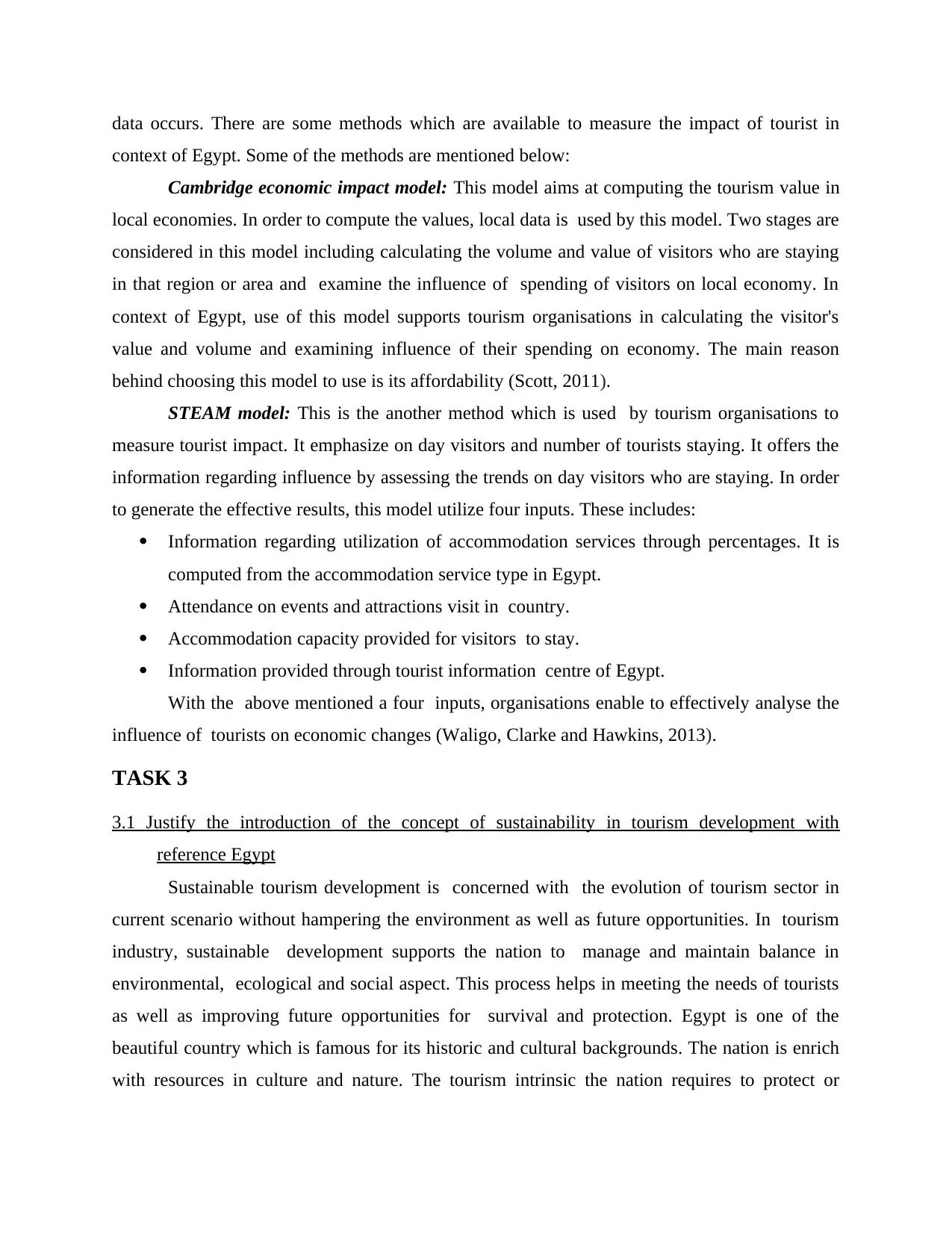
data occurs. There are some methods which are available to measure the impact of tourist in
context of Egypt. Some of the methods are mentioned below:
Cambridge economic impact model: This model aims at computing the tourism value in
local economies. In order to compute the values, local data is used by this model. Two stages are
considered in this model including calculating the volume and value of visitors who are staying
in that region or area and examine the influence of spending of visitors on local economy. In
context of Egypt, use of this model supports tourism organisations in calculating the visitor's
value and volume and examining influence of their spending on economy. The main reason
behind choosing this model to use is its affordability (Scott, 2011).
STEAM model: This is the another method which is used by tourism organisations to
measure tourist impact. It emphasize on day visitors and number of tourists staying. It offers the
information regarding influence by assessing the trends on day visitors who are staying. In order
to generate the effective results, this model utilize four inputs. These includes:
Information regarding utilization of accommodation services through percentages. It is
computed from the accommodation service type in Egypt.
Attendance on events and attractions visit in country.
Accommodation capacity provided for visitors to stay.
Information provided through tourist information centre of Egypt.
With the above mentioned a four inputs, organisations enable to effectively analyse the
influence of tourists on economic changes (Waligo, Clarke and Hawkins, 2013).
TASK 3
3.1 Justify the introduction of the concept of sustainability in tourism development with
reference Egypt
Sustainable tourism development is concerned with the evolution of tourism sector in
current scenario without hampering the environment as well as future opportunities. In tourism
industry, sustainable development supports the nation to manage and maintain balance in
environmental, ecological and social aspect. This process helps in meeting the needs of tourists
as well as improving future opportunities for survival and protection. Egypt is one of the
beautiful country which is famous for its historic and cultural backgrounds. The nation is enrich
with resources in culture and nature. The tourism intrinsic the nation requires to protect or
context of Egypt. Some of the methods are mentioned below:
Cambridge economic impact model: This model aims at computing the tourism value in
local economies. In order to compute the values, local data is used by this model. Two stages are
considered in this model including calculating the volume and value of visitors who are staying
in that region or area and examine the influence of spending of visitors on local economy. In
context of Egypt, use of this model supports tourism organisations in calculating the visitor's
value and volume and examining influence of their spending on economy. The main reason
behind choosing this model to use is its affordability (Scott, 2011).
STEAM model: This is the another method which is used by tourism organisations to
measure tourist impact. It emphasize on day visitors and number of tourists staying. It offers the
information regarding influence by assessing the trends on day visitors who are staying. In order
to generate the effective results, this model utilize four inputs. These includes:
Information regarding utilization of accommodation services through percentages. It is
computed from the accommodation service type in Egypt.
Attendance on events and attractions visit in country.
Accommodation capacity provided for visitors to stay.
Information provided through tourist information centre of Egypt.
With the above mentioned a four inputs, organisations enable to effectively analyse the
influence of tourists on economic changes (Waligo, Clarke and Hawkins, 2013).
TASK 3
3.1 Justify the introduction of the concept of sustainability in tourism development with
reference Egypt
Sustainable tourism development is concerned with the evolution of tourism sector in
current scenario without hampering the environment as well as future opportunities. In tourism
industry, sustainable development supports the nation to manage and maintain balance in
environmental, ecological and social aspect. This process helps in meeting the needs of tourists
as well as improving future opportunities for survival and protection. Egypt is one of the
beautiful country which is famous for its historic and cultural backgrounds. The nation is enrich
with resources in culture and nature. The tourism intrinsic the nation requires to protect or
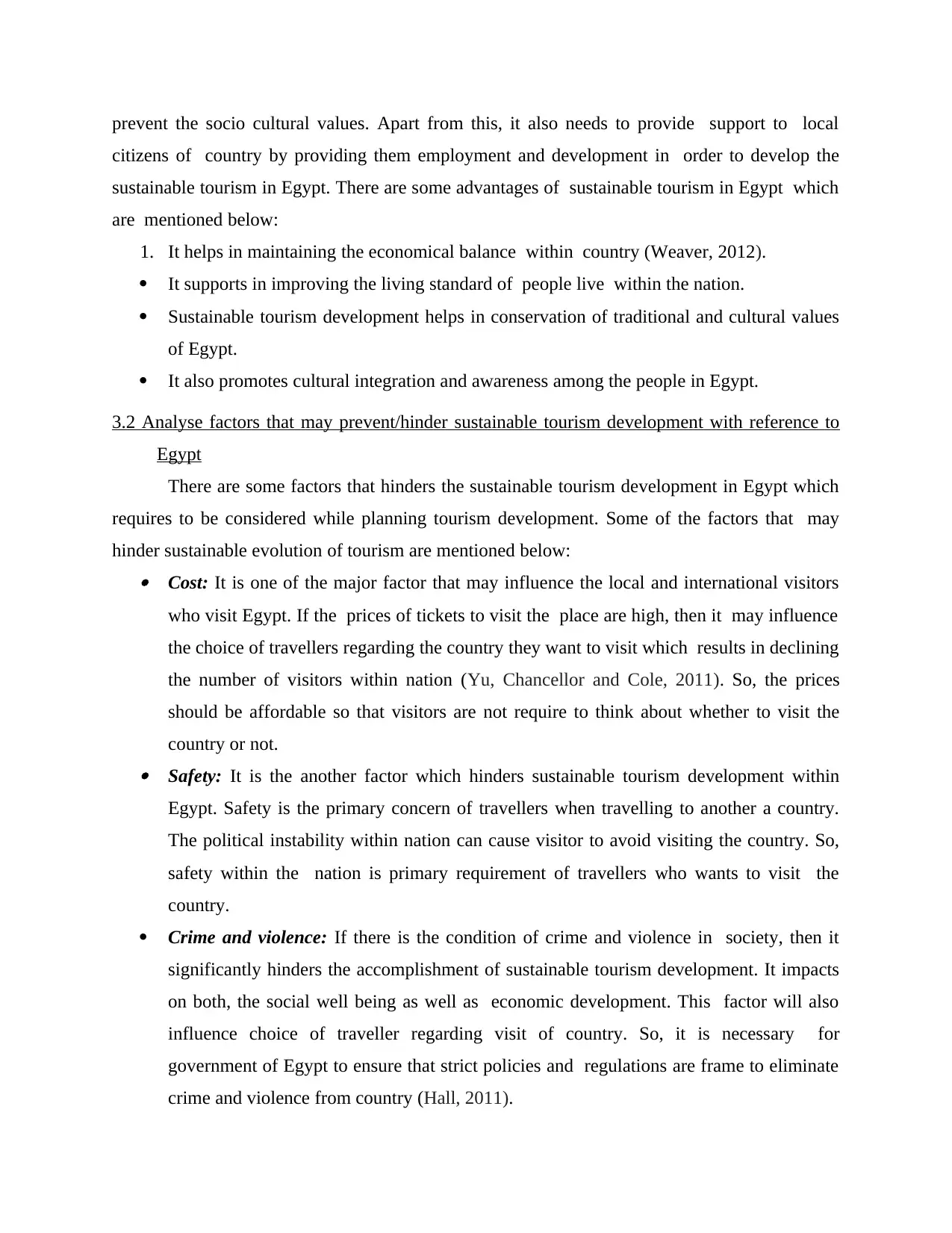
prevent the socio cultural values. Apart from this, it also needs to provide support to local
citizens of country by providing them employment and development in order to develop the
sustainable tourism in Egypt. There are some advantages of sustainable tourism in Egypt which
are mentioned below:
1. It helps in maintaining the economical balance within country (Weaver, 2012).
It supports in improving the living standard of people live within the nation.
Sustainable tourism development helps in conservation of traditional and cultural values
of Egypt.
It also promotes cultural integration and awareness among the people in Egypt.
3.2 Analyse factors that may prevent/hinder sustainable tourism development with reference to
Egypt
There are some factors that hinders the sustainable tourism development in Egypt which
requires to be considered while planning tourism development. Some of the factors that may
hinder sustainable evolution of tourism are mentioned below: Cost: It is one of the major factor that may influence the local and international visitors
who visit Egypt. If the prices of tickets to visit the place are high, then it may influence
the choice of travellers regarding the country they want to visit which results in declining
the number of visitors within nation (Yu, Chancellor and Cole, 2011). So, the prices
should be affordable so that visitors are not require to think about whether to visit the
country or not. Safety: It is the another factor which hinders sustainable tourism development within
Egypt. Safety is the primary concern of travellers when travelling to another a country.
The political instability within nation can cause visitor to avoid visiting the country. So,
safety within the nation is primary requirement of travellers who wants to visit the
country.
Crime and violence: If there is the condition of crime and violence in society, then it
significantly hinders the accomplishment of sustainable tourism development. It impacts
on both, the social well being as well as economic development. This factor will also
influence choice of traveller regarding visit of country. So, it is necessary for
government of Egypt to ensure that strict policies and regulations are frame to eliminate
crime and violence from country (Hall, 2011).
citizens of country by providing them employment and development in order to develop the
sustainable tourism in Egypt. There are some advantages of sustainable tourism in Egypt which
are mentioned below:
1. It helps in maintaining the economical balance within country (Weaver, 2012).
It supports in improving the living standard of people live within the nation.
Sustainable tourism development helps in conservation of traditional and cultural values
of Egypt.
It also promotes cultural integration and awareness among the people in Egypt.
3.2 Analyse factors that may prevent/hinder sustainable tourism development with reference to
Egypt
There are some factors that hinders the sustainable tourism development in Egypt which
requires to be considered while planning tourism development. Some of the factors that may
hinder sustainable evolution of tourism are mentioned below: Cost: It is one of the major factor that may influence the local and international visitors
who visit Egypt. If the prices of tickets to visit the place are high, then it may influence
the choice of travellers regarding the country they want to visit which results in declining
the number of visitors within nation (Yu, Chancellor and Cole, 2011). So, the prices
should be affordable so that visitors are not require to think about whether to visit the
country or not. Safety: It is the another factor which hinders sustainable tourism development within
Egypt. Safety is the primary concern of travellers when travelling to another a country.
The political instability within nation can cause visitor to avoid visiting the country. So,
safety within the nation is primary requirement of travellers who wants to visit the
country.
Crime and violence: If there is the condition of crime and violence in society, then it
significantly hinders the accomplishment of sustainable tourism development. It impacts
on both, the social well being as well as economic development. This factor will also
influence choice of traveller regarding visit of country. So, it is necessary for
government of Egypt to ensure that strict policies and regulations are frame to eliminate
crime and violence from country (Hall, 2011).
⊘ This is a preview!⊘
Do you want full access?
Subscribe today to unlock all pages.

Trusted by 1+ million students worldwide
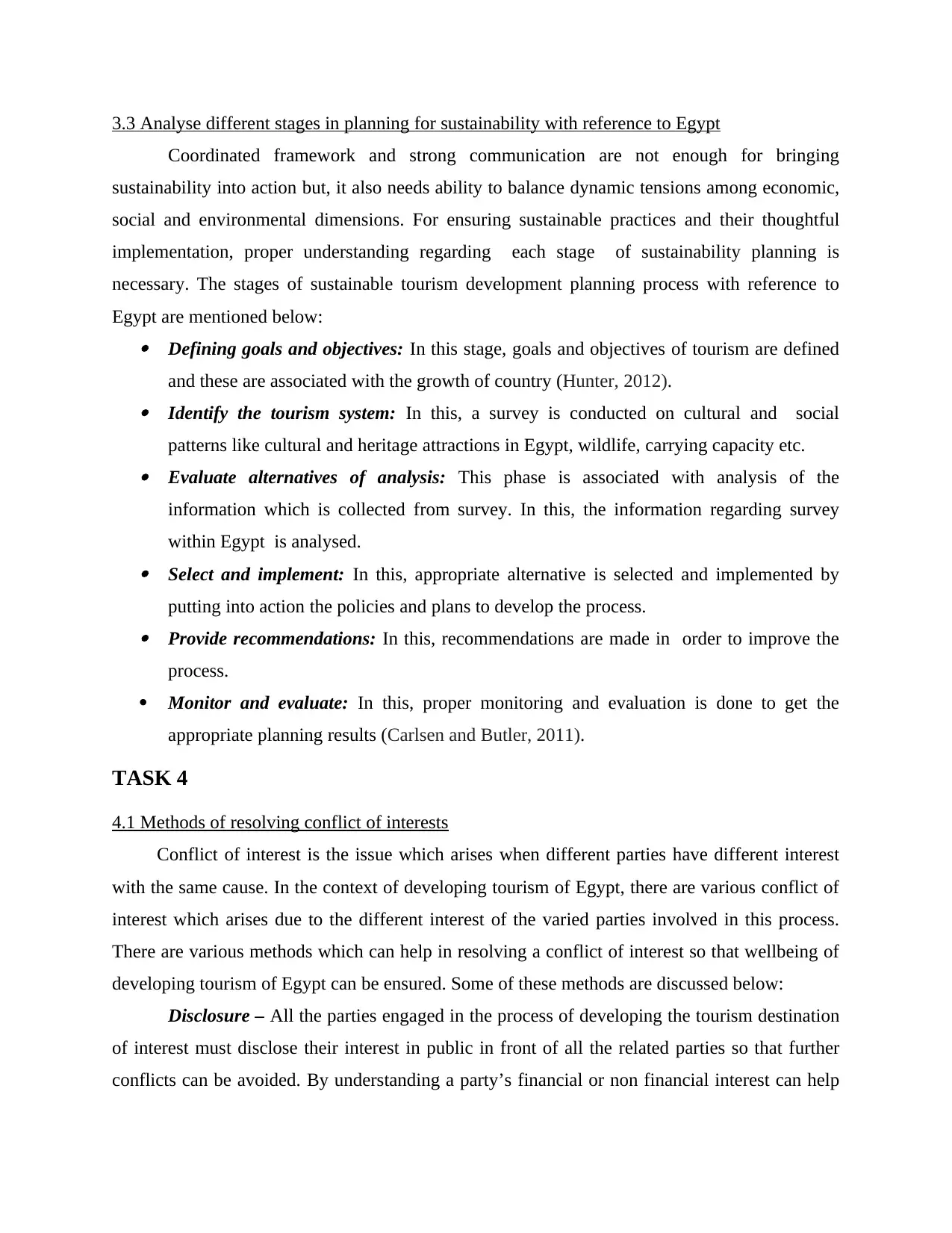
3.3 Analyse different stages in planning for sustainability with reference to Egypt
Coordinated framework and strong communication are not enough for bringing
sustainability into action but, it also needs ability to balance dynamic tensions among economic,
social and environmental dimensions. For ensuring sustainable practices and their thoughtful
implementation, proper understanding regarding each stage of sustainability planning is
necessary. The stages of sustainable tourism development planning process with reference to
Egypt are mentioned below: Defining goals and objectives: In this stage, goals and objectives of tourism are defined
and these are associated with the growth of country (Hunter, 2012). Identify the tourism system: In this, a survey is conducted on cultural and social
patterns like cultural and heritage attractions in Egypt, wildlife, carrying capacity etc. Evaluate alternatives of analysis: This phase is associated with analysis of the
information which is collected from survey. In this, the information regarding survey
within Egypt is analysed. Select and implement: In this, appropriate alternative is selected and implemented by
putting into action the policies and plans to develop the process. Provide recommendations: In this, recommendations are made in order to improve the
process.
Monitor and evaluate: In this, proper monitoring and evaluation is done to get the
appropriate planning results (Carlsen and Butler, 2011).
TASK 4
4.1 Methods of resolving conflict of interests
Conflict of interest is the issue which arises when different parties have different interest
with the same cause. In the context of developing tourism of Egypt, there are various conflict of
interest which arises due to the different interest of the varied parties involved in this process.
There are various methods which can help in resolving a conflict of interest so that wellbeing of
developing tourism of Egypt can be ensured. Some of these methods are discussed below:
Disclosure – All the parties engaged in the process of developing the tourism destination
of interest must disclose their interest in public in front of all the related parties so that further
conflicts can be avoided. By understanding a party’s financial or non financial interest can help
Coordinated framework and strong communication are not enough for bringing
sustainability into action but, it also needs ability to balance dynamic tensions among economic,
social and environmental dimensions. For ensuring sustainable practices and their thoughtful
implementation, proper understanding regarding each stage of sustainability planning is
necessary. The stages of sustainable tourism development planning process with reference to
Egypt are mentioned below: Defining goals and objectives: In this stage, goals and objectives of tourism are defined
and these are associated with the growth of country (Hunter, 2012). Identify the tourism system: In this, a survey is conducted on cultural and social
patterns like cultural and heritage attractions in Egypt, wildlife, carrying capacity etc. Evaluate alternatives of analysis: This phase is associated with analysis of the
information which is collected from survey. In this, the information regarding survey
within Egypt is analysed. Select and implement: In this, appropriate alternative is selected and implemented by
putting into action the policies and plans to develop the process. Provide recommendations: In this, recommendations are made in order to improve the
process.
Monitor and evaluate: In this, proper monitoring and evaluation is done to get the
appropriate planning results (Carlsen and Butler, 2011).
TASK 4
4.1 Methods of resolving conflict of interests
Conflict of interest is the issue which arises when different parties have different interest
with the same cause. In the context of developing tourism of Egypt, there are various conflict of
interest which arises due to the different interest of the varied parties involved in this process.
There are various methods which can help in resolving a conflict of interest so that wellbeing of
developing tourism of Egypt can be ensured. Some of these methods are discussed below:
Disclosure – All the parties engaged in the process of developing the tourism destination
of interest must disclose their interest in public in front of all the related parties so that further
conflicts can be avoided. By understanding a party’s financial or non financial interest can help
Paraphrase This Document
Need a fresh take? Get an instant paraphrase of this document with our AI Paraphraser
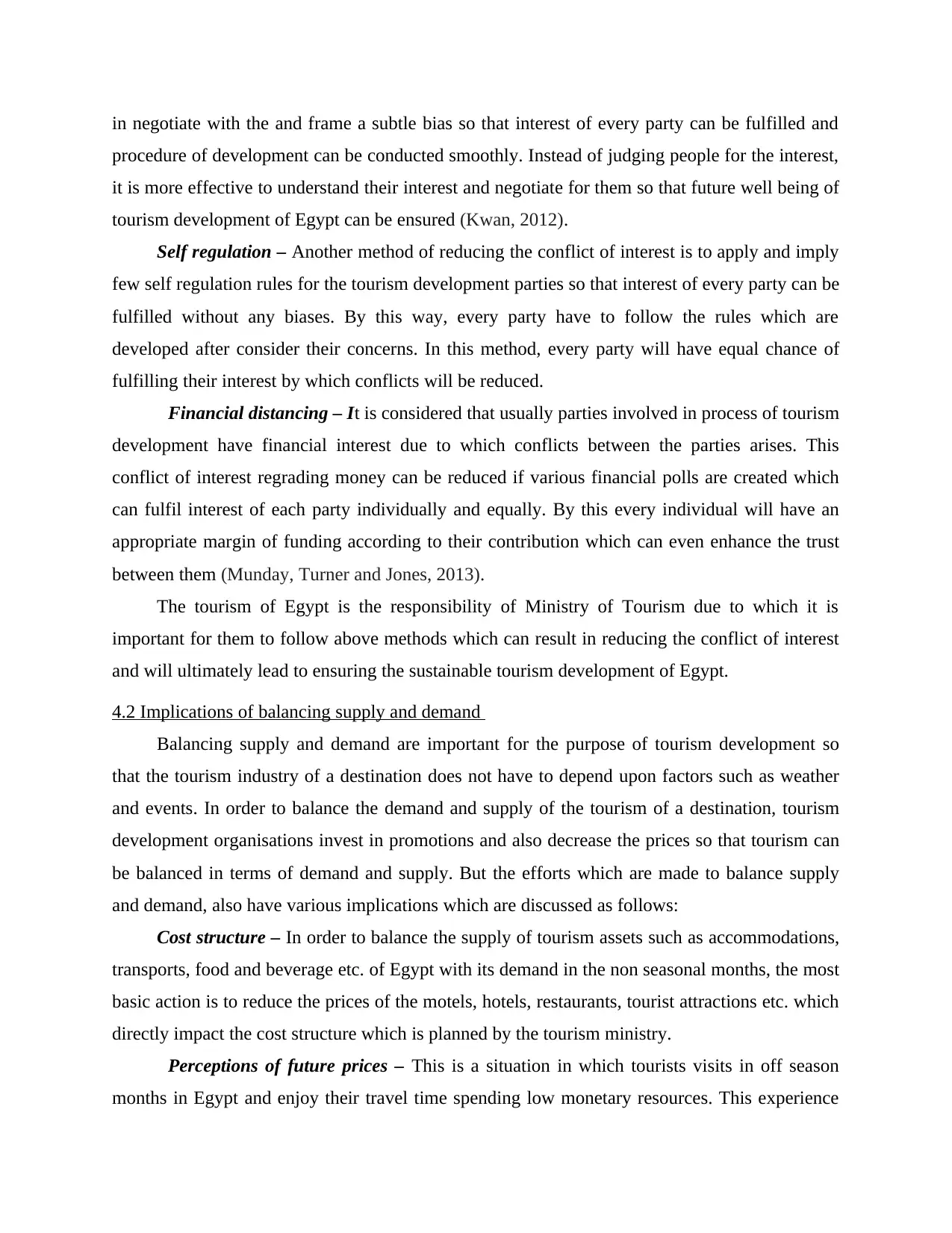
in negotiate with the and frame a subtle bias so that interest of every party can be fulfilled and
procedure of development can be conducted smoothly. Instead of judging people for the interest,
it is more effective to understand their interest and negotiate for them so that future well being of
tourism development of Egypt can be ensured (Kwan, 2012).
Self regulation – Another method of reducing the conflict of interest is to apply and imply
few self regulation rules for the tourism development parties so that interest of every party can be
fulfilled without any biases. By this way, every party have to follow the rules which are
developed after consider their concerns. In this method, every party will have equal chance of
fulfilling their interest by which conflicts will be reduced.
Financial distancing – It is considered that usually parties involved in process of tourism
development have financial interest due to which conflicts between the parties arises. This
conflict of interest regrading money can be reduced if various financial polls are created which
can fulfil interest of each party individually and equally. By this every individual will have an
appropriate margin of funding according to their contribution which can even enhance the trust
between them (Munday, Turner and Jones, 2013).
The tourism of Egypt is the responsibility of Ministry of Tourism due to which it is
important for them to follow above methods which can result in reducing the conflict of interest
and will ultimately lead to ensuring the sustainable tourism development of Egypt.
4.2 Implications of balancing supply and demand
Balancing supply and demand are important for the purpose of tourism development so
that the tourism industry of a destination does not have to depend upon factors such as weather
and events. In order to balance the demand and supply of the tourism of a destination, tourism
development organisations invest in promotions and also decrease the prices so that tourism can
be balanced in terms of demand and supply. But the efforts which are made to balance supply
and demand, also have various implications which are discussed as follows:
Cost structure – In order to balance the supply of tourism assets such as accommodations,
transports, food and beverage etc. of Egypt with its demand in the non seasonal months, the most
basic action is to reduce the prices of the motels, hotels, restaurants, tourist attractions etc. which
directly impact the cost structure which is planned by the tourism ministry.
Perceptions of future prices – This is a situation in which tourists visits in off season
months in Egypt and enjoy their travel time spending low monetary resources. This experience
procedure of development can be conducted smoothly. Instead of judging people for the interest,
it is more effective to understand their interest and negotiate for them so that future well being of
tourism development of Egypt can be ensured (Kwan, 2012).
Self regulation – Another method of reducing the conflict of interest is to apply and imply
few self regulation rules for the tourism development parties so that interest of every party can be
fulfilled without any biases. By this way, every party have to follow the rules which are
developed after consider their concerns. In this method, every party will have equal chance of
fulfilling their interest by which conflicts will be reduced.
Financial distancing – It is considered that usually parties involved in process of tourism
development have financial interest due to which conflicts between the parties arises. This
conflict of interest regrading money can be reduced if various financial polls are created which
can fulfil interest of each party individually and equally. By this every individual will have an
appropriate margin of funding according to their contribution which can even enhance the trust
between them (Munday, Turner and Jones, 2013).
The tourism of Egypt is the responsibility of Ministry of Tourism due to which it is
important for them to follow above methods which can result in reducing the conflict of interest
and will ultimately lead to ensuring the sustainable tourism development of Egypt.
4.2 Implications of balancing supply and demand
Balancing supply and demand are important for the purpose of tourism development so
that the tourism industry of a destination does not have to depend upon factors such as weather
and events. In order to balance the demand and supply of the tourism of a destination, tourism
development organisations invest in promotions and also decrease the prices so that tourism can
be balanced in terms of demand and supply. But the efforts which are made to balance supply
and demand, also have various implications which are discussed as follows:
Cost structure – In order to balance the supply of tourism assets such as accommodations,
transports, food and beverage etc. of Egypt with its demand in the non seasonal months, the most
basic action is to reduce the prices of the motels, hotels, restaurants, tourist attractions etc. which
directly impact the cost structure which is planned by the tourism ministry.
Perceptions of future prices – This is a situation in which tourists visits in off season
months in Egypt and enjoy their travel time spending low monetary resources. This experience
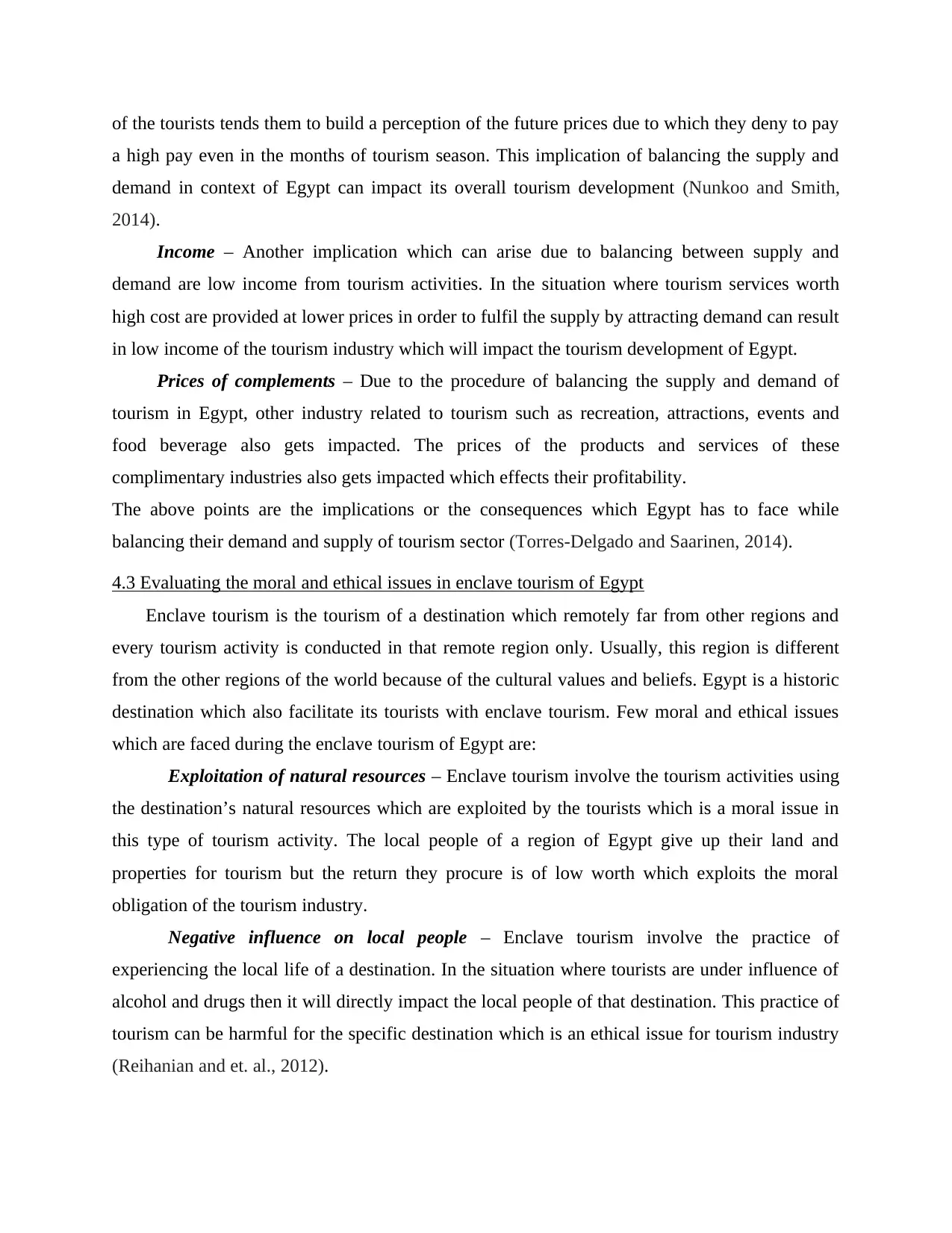
of the tourists tends them to build a perception of the future prices due to which they deny to pay
a high pay even in the months of tourism season. This implication of balancing the supply and
demand in context of Egypt can impact its overall tourism development (Nunkoo and Smith,
2014).
Income – Another implication which can arise due to balancing between supply and
demand are low income from tourism activities. In the situation where tourism services worth
high cost are provided at lower prices in order to fulfil the supply by attracting demand can result
in low income of the tourism industry which will impact the tourism development of Egypt.
Prices of complements – Due to the procedure of balancing the supply and demand of
tourism in Egypt, other industry related to tourism such as recreation, attractions, events and
food beverage also gets impacted. The prices of the products and services of these
complimentary industries also gets impacted which effects their profitability.
The above points are the implications or the consequences which Egypt has to face while
balancing their demand and supply of tourism sector (Torres-Delgado and Saarinen, 2014).
4.3 Evaluating the moral and ethical issues in enclave tourism of Egypt
Enclave tourism is the tourism of a destination which remotely far from other regions and
every tourism activity is conducted in that remote region only. Usually, this region is different
from the other regions of the world because of the cultural values and beliefs. Egypt is a historic
destination which also facilitate its tourists with enclave tourism. Few moral and ethical issues
which are faced during the enclave tourism of Egypt are:
Exploitation of natural resources – Enclave tourism involve the tourism activities using
the destination’s natural resources which are exploited by the tourists which is a moral issue in
this type of tourism activity. The local people of a region of Egypt give up their land and
properties for tourism but the return they procure is of low worth which exploits the moral
obligation of the tourism industry.
Negative influence on local people – Enclave tourism involve the practice of
experiencing the local life of a destination. In the situation where tourists are under influence of
alcohol and drugs then it will directly impact the local people of that destination. This practice of
tourism can be harmful for the specific destination which is an ethical issue for tourism industry
(Reihanian and et. al., 2012).
a high pay even in the months of tourism season. This implication of balancing the supply and
demand in context of Egypt can impact its overall tourism development (Nunkoo and Smith,
2014).
Income – Another implication which can arise due to balancing between supply and
demand are low income from tourism activities. In the situation where tourism services worth
high cost are provided at lower prices in order to fulfil the supply by attracting demand can result
in low income of the tourism industry which will impact the tourism development of Egypt.
Prices of complements – Due to the procedure of balancing the supply and demand of
tourism in Egypt, other industry related to tourism such as recreation, attractions, events and
food beverage also gets impacted. The prices of the products and services of these
complimentary industries also gets impacted which effects their profitability.
The above points are the implications or the consequences which Egypt has to face while
balancing their demand and supply of tourism sector (Torres-Delgado and Saarinen, 2014).
4.3 Evaluating the moral and ethical issues in enclave tourism of Egypt
Enclave tourism is the tourism of a destination which remotely far from other regions and
every tourism activity is conducted in that remote region only. Usually, this region is different
from the other regions of the world because of the cultural values and beliefs. Egypt is a historic
destination which also facilitate its tourists with enclave tourism. Few moral and ethical issues
which are faced during the enclave tourism of Egypt are:
Exploitation of natural resources – Enclave tourism involve the tourism activities using
the destination’s natural resources which are exploited by the tourists which is a moral issue in
this type of tourism activity. The local people of a region of Egypt give up their land and
properties for tourism but the return they procure is of low worth which exploits the moral
obligation of the tourism industry.
Negative influence on local people – Enclave tourism involve the practice of
experiencing the local life of a destination. In the situation where tourists are under influence of
alcohol and drugs then it will directly impact the local people of that destination. This practice of
tourism can be harmful for the specific destination which is an ethical issue for tourism industry
(Reihanian and et. al., 2012).
⊘ This is a preview!⊘
Do you want full access?
Subscribe today to unlock all pages.

Trusted by 1+ million students worldwide
1 out of 17
Related Documents
Your All-in-One AI-Powered Toolkit for Academic Success.
+13062052269
info@desklib.com
Available 24*7 on WhatsApp / Email
![[object Object]](/_next/static/media/star-bottom.7253800d.svg)
Unlock your academic potential
Copyright © 2020–2025 A2Z Services. All Rights Reserved. Developed and managed by ZUCOL.





